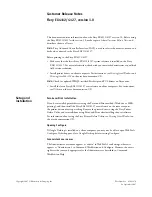
SW5502C
Wireless Serial Server
User Manual
Configuration and
setup
SSID
:
This
specifies the SSID
(
or network name
)
that SW550XC should connect to wirelessly
.
There is a
“
Scan
Network
”
button on the right of the empty text box
.
This button makes it possible to look for nearby available
wireless networks to attach to
.
Once clicked, it will start a scanning process and prompt a
window with a list
of available wireless networks
.
Detailed steps for setting the SSID or using Scan Network button will be
explained after this list
.
BSSID
(
MAC Address
):
This refers to
access
point
’
s MAC address on which the SW550XC should connect to
.
Enabling this option by checking the box behind it will lock SW550XC to that access point
.
Therefore,
SW550XC would not roam to another access point with the same SSID
.
Wifi-Direct Group Owner: Click to enable the function. This function will allow SW550XC to find nearby Wi-Fi
Direct device and form a Wi-Fi Direct group to communicate over a peer-to-peer link without wireless access
point in the infrastructure mode. The group owner will work as a access point in the infrastructure mode and
the other devices join the group as clients. For more details, please refer to Section 5.3.5
WPS BUTTON
:
The WPS
acronym stands for Wi
-
Fi Protected Setup and
the PBC stands for Push
Button
Configuration
.
To use this feature, first trigger the WPS process in a
WPS supported access point
(
AP
)
and
click on the Start WPS PBC button on SW550XC’s UI
.
The AP and the SW550XC should connect automatically
.
Note that the Topology setting
(
next option
)
in this case should be
Infrastructure and the Band Mode
(
option
after the next
)
should be Auto so that the WPS can work
.
Note that this button is unavailable when the
Wireless Profiles is enabled
.
Topology
:
There are two type of wireless network topologies which are Infrastructure
(
for connecting to an
Access Point
)
or Ad Hoc
(
for connecting to a wireless client
).
Note that
the
Ad Hoc mode is unavailable when
the Wireless Profiles is enabled
.
Band Mode
:
This option allows user to select the radio frequency band which are supported by IEEE 802
.
11b,
802
.
11b
/
g, and 802
.
11b
/
g
/
n standards
.
It is recommended to
leave this option to Auto for SW550XC to sense
for the best available mode automatically
by checking the Auto box
.
Channel
:
This option allows the user to specify the radio channel number for SW550XC to operate on
.
However, the available channels would depend on the Band Mode and the regulatory domain
(
CN, EU, TW, or
US
)
selected in the Wireless Advanced Settings
(
discussed next section
).
This option is disabled when the
Band Mode is set to Auto
.
Bandwidth
:
This option allows SW550XC to
select between 20 MHz or 40 MHz
radio bandwidth usage
.
The
latter fills a larger spectrum; hence, it provides a better throughput if it is allowed by the Access Point
.
However,
it is not recommended to use 40 MHz at 2
.
4 GHz band for IEEE 802
.
11b
/
g
/
n standards
.
Channel
:
This option specifies
the
radio channel number that SW550XC will use which can be chosen from
the drop down list between 1 and 11
.
Authentication Mode
:
This option allows the
selection of wireless network authentication mechanisms which
could be
OPEN, SHARED, WPA
-
PSK, WPA2
-
PSK, WPA2
(
PEAP
)
, WPA2
(
EAP
-
TLS
)
, and WPA2
(
EAP
-
TTLS
).
Encryption Type
:
This option specifies the encryption algorithm for wireless connection which could be
WEP,
TKIP and AES
.
However, please beware that WEP and TKIP are not supported by the IEEE 802
.
11n standard;
therefore, the wireless link speed would be limited to 54Mbps
.
WEP Key
:
This option is
enabled when Authentication Mode is set to OPEN and Encryption Type
is set to
WEP
.
Up to 4 different hexadecimal or ASCII keys can be entered in this option
.
WPA
-
PSK
/
WPA2
-
PSK Passphrase
:
This option is
enabled when Authentication Mode is set to WPA
-
PSK or
WPA2
-
PSK
.
The passphrase can be between 8 and 63 characters long
.
WPA2
(
with RADIUS
):
Depending on
selected Authentication Mode, different fields in this option will be
enabled
.
WPA2
(
PEAP
)
would require you to provide the user, password, and the certificates
.
WPA2
(
EAP
-
TLS
)
would require you to provide the certificates and private key password
.
WPA2
(
EAP
-
TTLS
)
would require
you to provide the user, the password, and the certificates
.
Please note that only
*.
pem certificates are
supported
.
Please remember that 2
.
4 GHz frequency can be easily interfered by other wireless devices that operate in the same
spectrum
(
namely, Bluetooth, ZigBee, microwave oven, etc
.)
; therefore, it is better to choose the IEEE 802
.
11b
/
g/n
which operates in the 2.4 GHz spectrum when the user
’
s network
allows
.
















































